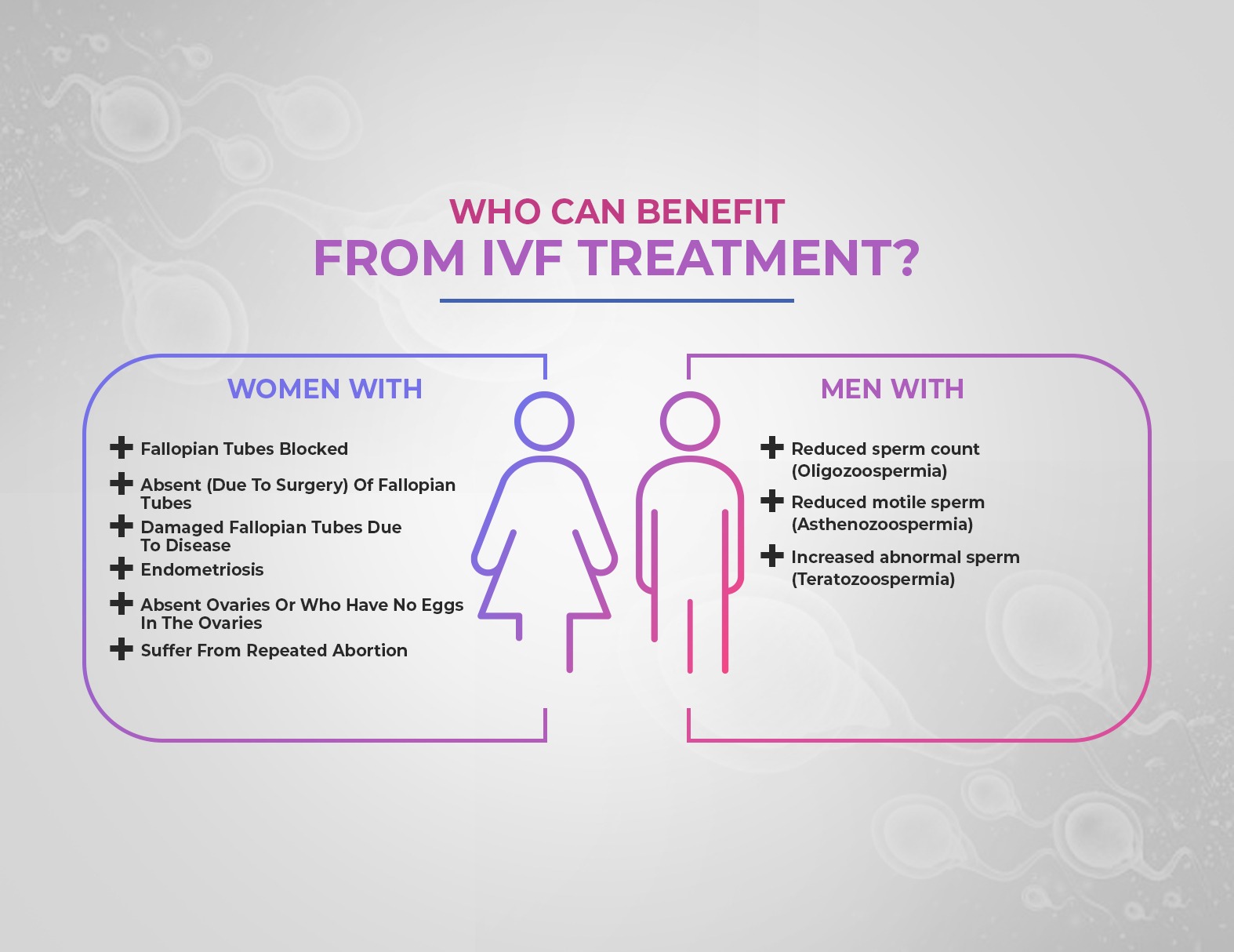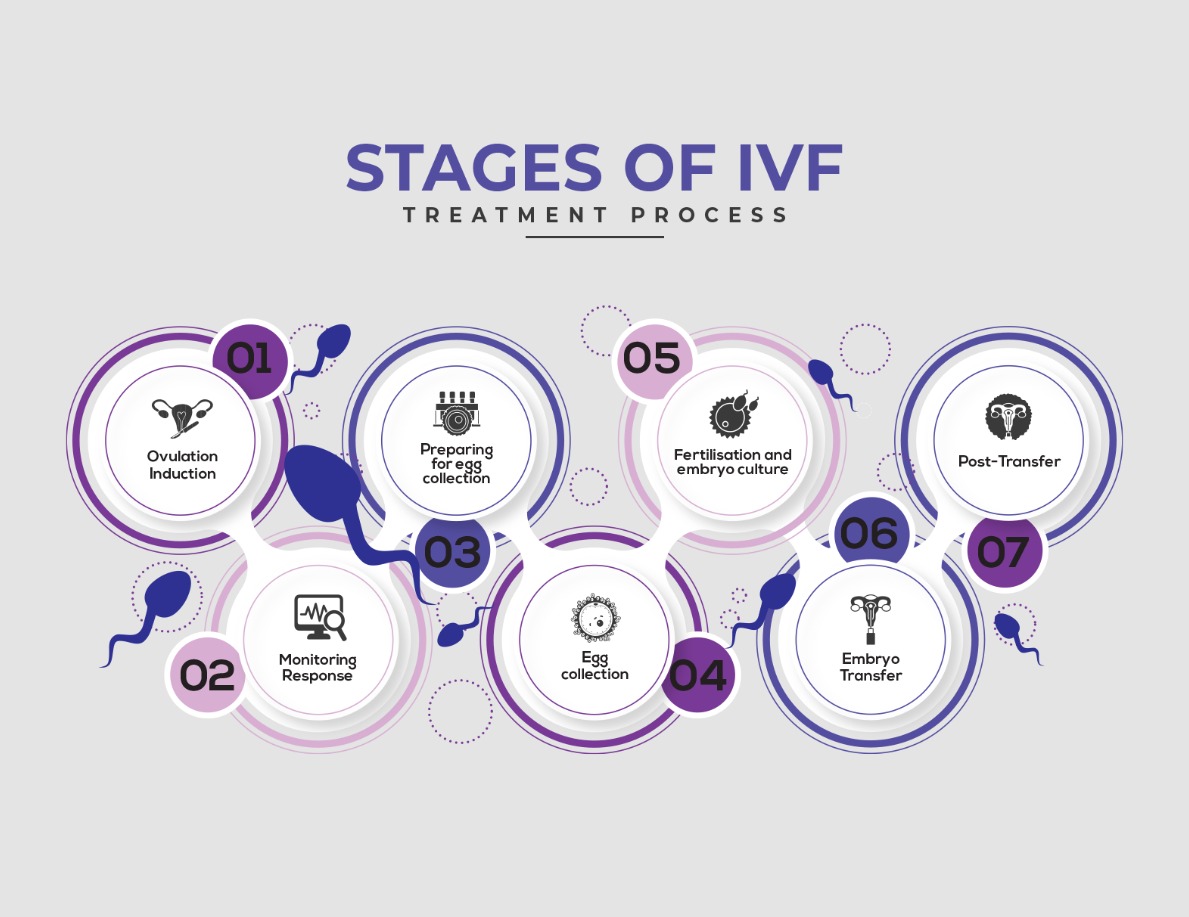IVF is a process in which a woman’s eggs are taken out of her ovaries and fertilised in a laboratory with a man’s sperm. The fertilised eggs then develop into embryos, which are transferred to the woman’s uterus by a procedure called embryo transfer (ET).
Who Can Benefit from IVF Treatment?
IVF treatment benefits intended parents, LGBT partners, and individual parents in achieving a successful healthy pregnancy and healthy childbirth. The treatment paves the way to help individuals successfully have a family. IVF treatment is beneficial for the
- The Women who has :
- both Fallopian tubes blocked, absent (due to surgery), or damaged due to disease.
- Endometriosis, i.e. the presence of endometrium (lining of the womb) outside the uterus.
- absent ovaries or who have no eggs in the ovaries
- who suffer from repeated abortion. IVF with Preimplantation Genetic Testing for Aneuploidies (PGT-A) may help in these cases.

- The husband who has a :
- Reduced sperm count (Oligozoospermia)
- Reduced motile sperm (Asthenozoospermia)
- Increased abnormal sperm (Teratozoospermia)
- Sperm antibodies in the wife’s and or husband’s serum.
- Couple who have :
- history of genetic disorders may be helped with IVF.
- Unexplained infertility (refers to couples in whom no obvious pathology is found but cannot conceive).
Stages of IVF Treatment Process
We, here at Ankuran, follow the IVF treatment process step by step. The treatment is done meticulously by following the procedure.

Step 1: Ovulation Induction
In an average woman, each menstrual cycle results in the production of one egg. However, several eggs are necessary for the IVF treatment process. The likelihood of creating a healthy embryo improves when more than one egg is used. You'll be given fertility medications to boost your body's egg production. FSH, or Follicle Stimulating Hormone, is injected into the body to make the ovaries produce more follicles, each of which could hold an egg. These stimulation injections are subcutaneous (under the skin) and administered regularly. One of the most used fertility medications in the IVF treatment process is gonadotropin-releasing Hormone (GnRH), where gonadotropin secretion is suppressed to prevent premature ovulation. After optimal suppression is achieved, recruitment of multiple follicles by regular injections of gonadotropins follows.
Step 2: Monitoring Response
The growth of follicles is tracked with ultrasound images and hormone tests. While you are getting these shots, you will be scanned on average four times over the course of two weeks to check on the number and size of the follicles. With the help of these scans and blood tests that are done at each scan, we can figure out the best time to collect them and adjust your drug doses as needed to get the best results.
Step 3: Preparing for Egg Collection
Once the lead follicles reach their required appropriate size (17–22 mm), the egg's final maturation is done by HCG administration. The final preparation for the collection of the egg involves a hormonal injection given 36 hours pre-operatively, and the egg is retrieved after 34-36 hours after HCG injection.
Step 4: Egg Collection
Mature eggs are retrieved within 34-36 hours after HCG administration. It is performed in a surgical suite. Transvaginal sonography is used to help retrieve eggs from the ovaries while the patient is under general anaesthesia. The embryologist then takes out the fluid from each follicle, which generally has an egg in it, and puts it in a test tube to be examined.
From the picture of the ultrasound scan, it is hard to tell how many eggs are available. So, we often get fewer eggs and sometimes get more than we expected before the operation. Even if follicles show up on the screen, we sometimes don't get any eggs even though they are there. If this happens, the treatment cycle can't move on to embryo transfer, and you'll be given time to talk to the doctor about your choices.
Step 5: Fertilisation and Embryo Culture
The eggs will be fertilised in the laboratory. If there are concerns about sperm quality ICSI will be recommended to fertilise the eggs. If there is enough sperm, they are added to the culture dish with the egg and left there to fertilise while the dish is incubated overnight.
The embryologist will check the eggs the following day to see whether they have been fertilised and then later to see if any embryos have developed further. It is possible to freeze additional well-developed embryos if there are more than three for eventual later transfer.
Step 6: Embryo Transfer
Embryos will usually be transferred on Day 3 0r Day 5. The transfer of embryos is a simple process that doesn't need to be done under general anaesthesia. Embryos are loaded in a catheter and transferred under transabdominal ultrasound guidance into the uterus by a catheter passing through the cervix. If the operation succeeds, it takes six to ten days for the implantation to occur. After the transfer, a course of medicines to assist the luteal phase will be provided to you. The amount we transfer will vary depending on how old you are, how good the embryos are, and your medical history. This is done to increase the chance of success. At the same time, minimise the risks of multiple pregnancies.
Step 7: Post-Transfer
A pregnancy blood test is carried out after two weeks following extraction. You will be taking progesterone supplementation and other medication prescribed by your doctor at this time to support the lining of the uterus. If the test is positive and the patient is seen to be four weeks pregnant, then progesterone supplementation is usually continued until week 12 of the pregnancy.
Precautions After IVF Treatment
- Generally, it’s best to avoid strenuous activity, heavy lifting, and other activities that include or may entail jarring motions during the IVF treatment duration.
- Take the medicines your doctor gives you, as they have been chosen to increase your chances of getting pregnant.
- Avoid drinking alcohol, smoking, being around cigarettes, and being around X-rays
- Please consult your doctor before taking any medication.
Benefits of IVF Treatment:
IVF has numerous plus points. Let’s find out how IVF treatment benefits individuals wanting to be parents.
IVF works where other infertility treatments fail : In some cases, patients undergo a range of fertility treatments before arriving at the IVF. Some causes of infertility, like blocked fallopian tubes, serious male infertility factor, low ovarian reserves, and/or advanced maternal age (usually any woman over 38), will make your doctor suggest IVF.
It can be used by anybody : IVF treatment is not only for heterosexual married couples. It is used by single women, same-sex couples, individual parents, and even surrogate or gestational carriers.
You can use eggs and/or sperm from a donor : There are times when a fertility specialist may recommend using donated eggs and/or sperm, which increases your possibility of getting pregnant in the first or the second round.
You have control over timing : Patients who are focused on their careers or who may have a unique life situation that affects precisely when they want their baby to be born will find that IVF benefits them by giving them more overall control. Their eggs or embryos are cryopreserved for future use; you can choose the time frame when you want to get pregnant and give birth. It also helps you select your children’s age gap, which works best for your family planning.
Increase your chances of having a healthy baby : Genetic screening is a powerful technology that helps to ensure your baby is born healthy. Hopeful parents who use IVF treatment can have preimplantation genetic testing (PGT) performed on the embryo before it is transferred to the woman’s uterus. This test ensures the fetuses used during IVF are free of known genetic markers. These can be linked to dangerous diseases like cystic fibrosis (CF), Down’s syndrome, sickle cell anaemia, and Tay Sachs’s disease, which may be life threatening to you.
Decrease your chances of miscarriage : Genetic abnormalities are the most common causes of miscarriage. It makes the body terminate the pregnancy biologically. PGT test determines the genetic viability of an embryo ahead of time. It makes sure that mothers have an increased likelihood of achieving a healthy pregnancy and carrying the baby regularly, all the way to term, without miscarrying.
Increase your chances of conception : IVF with PGT has a higher success rate of conception than other assisted reproductive technology. In order to achieve higher chances of women’s fertilisation, multiple cycles are used if necessary to have a healthy pregnancy and live the birth of a child.
Major Risks of the IVF Treatment Process
There are several IVF treatment benefits; however, there are certain risks that patients might face during IVF treatment. Let’s see a few of them:

